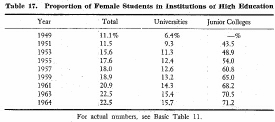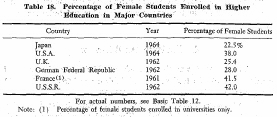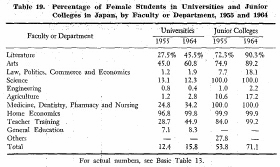| Home > Policy > White Paper, Notice, Announcement > White Paper > EDUCATIONAL STANDARDS IN JAPAN 1965 > CHAPTER1 3 (3) | ||
The average percentage of female students from 1934 to 1936 enrolled in institution of higher education was 9.8 per cent. This percentage reached 22.5 per cent in 1964. The percentage of female students in junior colleges was 71.2 per cent in that year.
The number of female students in higher institutions was approximately 18,000 in 1935. In 1951, shortly after the introduction of the modern school system, total female enrollment exceeded 48,000 and reached 225,000 in 1964.

The percentage of female students in higher institutions was lower in Japan than in the other major countries (it Europe and the U.S.A.).Female students represented 42.0 per cent of total enrollment in higher education in the U.S.S.R., 41,5 per cent in France, and 38.0 per cent in the U.S.A.
The percentage of female students in the various faculties and departments of universities and colleges in 1963 is shown below.


In universities, the percentage of female students in 1964 other than home economics (with 99.8 per cent), was highest in such faculties as arts, literature, teacher training and nursing.
Generally speaking, the percentage of female students was high in all departments of junior colleges except engineering and agriculture.
The female students in institutions of higher education were distributed by department in 1964 as follows: literature course, 36.7%, home economics 27.6%, teacher training, 16.4%, arts, 5.6% and other, 13.7%. The percentages of female enrollment in the departments of law, politics, commerce and economics and in the departments of science and technology were very low.
| Back to Top | MEXT HOME |